Yeah, yeah, I know. Sounds too good to be true, right?
For sure you’re thinking: “A ‘scientific’ way to make the ‘perfect’ post?… Does such thing as a perfect blog post even exist?
Even though you may have your doubts, let me take your skepticism away, and tell you that there IS a way to make the perfect blog post, and I’ll tell you exactly how, not in ONE article, but in TWO. I’ve accumulated so many details, data and information, I had to put together this series of articles.
¡Hell yeah!

Warning: Read this before creating the perfect blog post:
Before I start with the “scientific” part, I want to quickly make something clear and use the words of the social media genius, who I personally appreciate most, Jon Loomer, and says this about “content“. It goes something like this:
“I’m sick of people blaming Facebook because nobody likes or shares their posts. If you don’t get likes, it’s not Facebook, it’s because your content sucks. Face it and stop complaining.”
(I can’t remember his exact words, nor did I find the paragraph to quote it. But that’s what I remember more or less about what he said.)
What am I getting at? All the technical and scientific data that we’re going to cover in detail below, won’t work wonders if your content “sucks” to begin with, as Loomer says.
Here’s a quick overview of the topics we’ll develop in this article in order to achieve the perfect blog post:
1- The Perfect Headline: how to write attractive titles and headlines: characteristics, number of words, formulas, optimization for readers, SEO, and how to make them clickable. Also, how to create a meta description that works. Info that will convince you to do your job well.
The perfect body:
(No, we’re not talking about Kim Kardashian’s or Jennifer Lopez’s or this guy’s – :

We’re talking about the development of the perfect body of the text:
2- The Perfect Length of your content: factors influencing the amount of words. What works best for readers and for Google (SEO).
3- How to create the Perfect Intro Paragraph to catch your reader’s attention: characteristics, the science of curiosity, formulas, and ideas to implement now.
4- Writing so that even antsy people stop to read your content: the inverted pyramid of journalism.
5- The power of storytelling: the title draws the attention, but the story is what backs it up. Tricks and features that’ll make readers devour your post from start to finish.
6- Design Tricks for making your text scannable: number of words per line, text width, white space, font size, line spacing, and other amazing facts that’ll surprise you.
7- Images: why use them and some legal aspects that you should keep in mind.
8- Virality: tools for getting your content to be shared over and over again.
9- A check list that you should use to make sure you don’t forget anything. 🙂
3 Scientific reasons that will convince you to learn how to create the perfect blog post
Reason 1: Do you know how long it takes for the average person to decide whether or not they’ll stay on your page?
“How long do you think users remain on a site before leaving? It’s an eternal question, but the answer is always the same. Not much”
You’ll have only 10 seconds to impress the reader with your value proposition (headline), and get them to stay for about 15 seconds longer on your site. During those few seconds, they “evaluate” your content and decide whether it’s useful to them or not, and finally decide if they’ll read the whole thing or not.
The quote from the first paragraph is by Jakob Nielsen, one of the most renowned engineers and researchers in the world, specializing in online behavior of users and web usability.
People become very skeptical when looking for information, because, as Nielsen said, they’ve had countless experiences with very poor content or designs. They behave accordingly to avoid wasting more time than the absolutely necessary.
Nielsen also says in respect:
When people have been on a site for 30 seconds, the chances of abandoning the page reduce drastically, from that moment and on.
In the table below, we can analyze what we said before: the vertical column indicates the probability of leaving the page, in percentages, in relation to the time spent on it, in seconds:
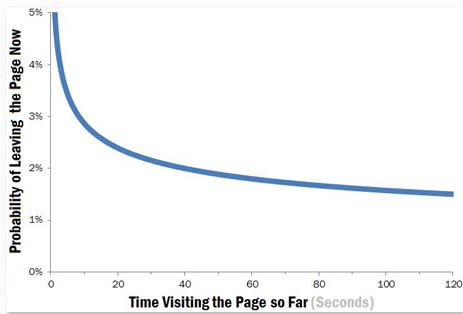
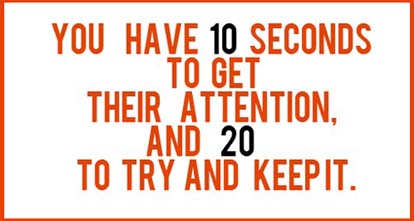
Reason 2: In the case that your reader decides to stay on your site … Are you absolutely certain that they’ll actually read your content? Do you know how they read online?
Nielsen says people don’t read, they scan the text.
This article will help you write your post to be as scannable as possible so that people can “read” it from start to finish quickly.
The route that the eye takes to “scan” a page has an F shaped pattern.
Let’s take a look:
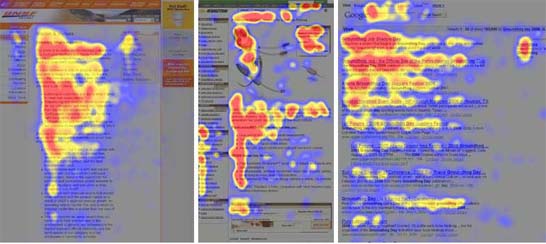
- General behavior, especially in the initial stages, is to scan through the text and the site. However, the personality of each reader and the circumstances of the search also influence this aspect.
- The first 2 paragraphs are critical and must demonstrate that the post contains the answer they’re looking for.
- The titles, headings, and first few paragraphs should have the keyword on the left side. As this is where their journey begins.
Reason 3: Do you know what your “potential readers” are looking for when surfing and sniffing around dozens of pages per minute?
There are many different reasons or circumstances under which people surf the web, but most of them are looking for an answer to something. Due to the amount of information they have access to, it seems almost impossible to find the perfect answer. So, we tend to settle and stay on the site that we feel “the most satisfied” with and think is going to give us the solution we’re searching for.
TIP: state the answer quickly, have a good classification of your topics, and write clearly.
In this article, we’ll give you some techniques for writing headlines and intro paragraphs that captivate and quickly satisfy your reader.
Are you ready? All right. Let’s get started.
1- The perfect headline.
The facts:
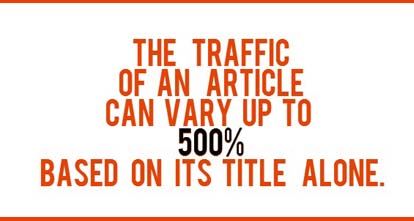
“Optimization of headlines is a dangerous game.”
“Realtime click data causes many publishers to over-optimize and manipulate readers into clicking stories they don’t actually want to read… In most cases it would be better for readers if the information was included in the headline so you only click if you actually are interested in reading the whole story.”
Who said this? The founder of BuzzFeed, one of the world’s biggest publishing platforms for viral news. Obviously, it’s a lesson they’re learning, the creators of the sensational headlines themselves.
The dilemma you have to solve for yourself: building trust long-term or earnings lots of clicks short-term?
Maybe you can achieve both, but the fact is that you need to learn how to write great headlines, either to get a lot of clicks, or to attract loyal readers who want to devour all of your content.
Want to know exactly how to do it? Keep reading.
1.1- Basic properties that every headline needs to have in order to work and be super appealing:
Headlines must…
a- Be Specific: Include facts and concrete information. Specificity can also be applied to create a mental image, using names, numbers, and descriptions.
b- Useful: Go straight to the problem that the reader has in mind and needs to solve.
c- Generate a sense of urgency: It’s not enough to just be interesting. It’s also no good if the reader clicks on your article and leaves the tab open to “read it later” That “later” never comes.
d- Engage a certain audience: Imply or identify in your headline that your article is for a selected audience.
We’ve already referred to this in our article: 5 tricks for writing great headlines on Twitter and Facebook as awesome and clickable as Buzzfeed’s.
In that article, we highlighted the following:
“Find the commonalities of your community, what you think can unite them under the same headache, laugh, memory, concern, doubt, or search for solutions, and create content based on that.”
Mel Martin, a legend in copywriting, shot to fame with his headline: “For golfers who (…)”, and frequently used this technique. This super effective formula still applies even today.
Another Example:
Get the point?
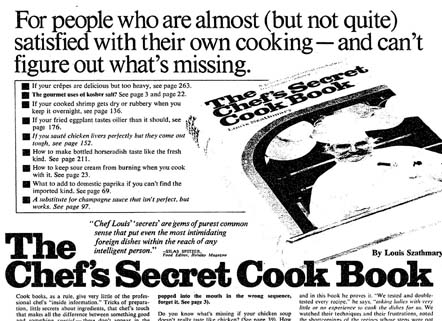
TIP: Negatives are perhaps so effective because they’re more intriguing and awaken our insecurities. For example, you can use “stop”, “the worst thing”, and “never.”
Remember this formula of you want to write great headlines:
# Number + adjective + keyword (the answer to their need) + rational aspect + promise
The order can be changed according to the circumstances, but this would be a simple example:
10 incredible secrets to be happier based on scientific data and that you can quickly apply to your life.
1.2 How many characters should a title have?
Keep in mind the following points:
a- So, now we know that readers scan the body of the text, but, watch out, they also scan through headlines too. Apparently, they focus mostly on the first 3 words and last 3 words of the headline. So, the most important aspects should be distributed there.
TIP: The minimum length advisable for headlines, based on this observation, is 6 words.
b-Title Tag: Google increased the font size of the titles listed in search engine results; therefore, they’ll only display the first 40 characters of your title. This means, you should include the most important part in that space.
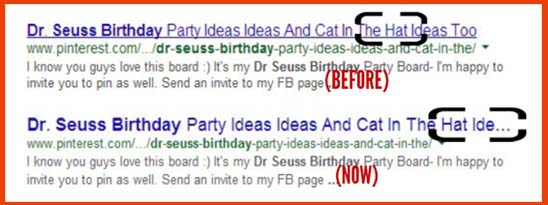
You can use this —> link, which includes a tool that lets you write your headline and see how it will appear in Google’s results.
c- SEO (1): the “spiders” from Google scan your content quickly to identify what your post is about, and evaluate its relevance, and keyword density in your title and headings (i.e., in H1, H2 and H3.), and in the permalink.
The permalink is the URL of your post. Many people pay attention to this, and it’s another factor to influence someone to click on your post in the result list. We’ve created an article especially for beginners who have no idea how to optimize SEO, and in it we cover this in more detail.

d- SEO (2): remember that Google now delivers search engine results, based on a semantic analysis of all the content in your article, and not just because your title matches the keyword. Try to use synonyms and related information to your keyword. That way, your content will have more chances to appear in different search results, and not only those that match the word exactly.
e- Social Networks: On Facebook, there are no space limitations, but your title should also tweetable. That means it shouldn’t exceed 140 characters. I’ll show you the formula that we use here at Postcron.
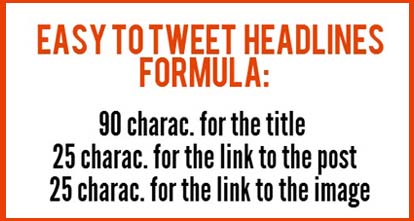
The body of the post
2. The perfect length of your post
Long articles are the most shared and read among online readers.
Surprised? Keep reading and I’ll explain in detail.
I- Factors that influence content length:
The excellent Neil Patel, in one of his articles, indicates that there are certain aspects that make a post valuable and distinct, and shouldn’t be sacrificed to try to meet a specific length:
i- The essence: it depends on what you want to say. If the concept and the central part of your content you can be said in 100 words, then you don’t need to more than that. However, if to convey the essence and value of information, you need 2000, then, that’s o.k. too.
ii- Style: if it’s conversational and interactive, it will be longer. If it’s straightforward, obviously it’ll be shorter. Everyone uses the example of Seth Godin, as he’s a marketing genius and his blog is unlike any other because most of his posts are only 250 words. You’ve got to define your own style. (But careful, there’s only one Seth Godin)
iii- Frequency: There are some sites that share content every day because something short and quick to read works better for them. Others excel at delivering highly detailed and complete articles once a week because more time is needed to read them.
iv- Structure: how an article is shaped and how the concepts are structured impacts its length, as well as its legibility and time it takes to read.
v- Purpose: every content strategy has a purpose, and every article corresponds to that purpose. For example: generate engagement, position a product, generate brand awareness, get emails, generate conversions, educate, etc… Each one has a specific nature, and this will influence a number of words in your articles.
vi- Audience: the needs of your audience, their lifestyle, their characteristics, personality will obviously affect the length. The goal is to make content that you know your audience will read.
vii- Format: infographics, videos, presentations, are not the same as a post 100% developed with words.
2.2- What is the ideal number of words for the perfect blog post?
These facts will convince you that making your content at least 1500 words is well worth it.
Fact 1: Articles that are in the top 10 results produced by Google’s search engine have at least 2000 words. Whatever the keyword.
Let’s take a look at the following chart: (vertical: word count/ Horizontal: ranking position of results)
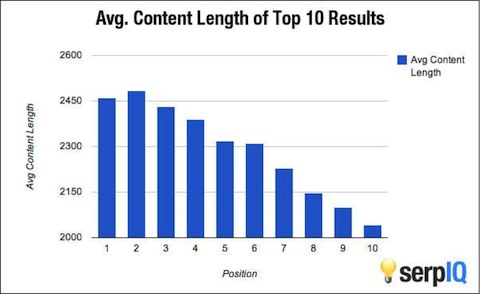
Fact 2: Semantic search (meaningful searching for content related to your keyword). These days, Google is not only focusing on tracking and identifying textual matches your keyword but analyzing words semantically related to the search criteria too. Spiders go through your whole article, identifying synonyms and understanding the context in order to deliver results that are more meaningful for users.
That is, the more words your post has, the more versions of your keyword you can use. A greater variety means your keyword will be stronger and have more potential, which is essential for creating a rich and high valued context for the search. (= Excellent SEO optimization)
Fact 3: Indexing. The higher number of words your post has, the better it can be indexed. More indexing means better performance of your site and content in search engine results. Check out this link from the support area to learn more about Google indexing: here
Fact 4: In a small study by Neil Patel in his blog, he was able to confirm that long articles perform better than short ones. Posts with 1500 words or more get 68% more tweets and 22% more likes on Facebook than shorter ones.
Fact 5: the ideal reading time should not exceed 7 minutes, which is equivalent between 1600 and 2000 words https://medium.com/data-lab/74b9f41509b. The curve below shows the maximum point of the reader’s attention occurs at minute 7. Then it begins to decline.

There’s no exact number of words for a perfect length, but everything indicates that you shouldn’t be afraid to create detailed and lengthy content. On the contrary, it’s much better if you do.
This doesn’t end here….
So, we’ve gotten this far with Part 1 of the series: “How to create the perfect blog post” Although we’ve advanced quite a lot, there is still a lot more to cover and learn. So, don’t miss the next article if you want to find out exactly how to write super attractive intro paragraphs, quickly capture the attention of people who click on your post, how to write paragraphs so that even antsy people read them, how to use design principles to make your articles super-scannable and easy to read, and other science and psychology tricks to take every piece of your content even further. Stay tuned for the next post, PART 2.